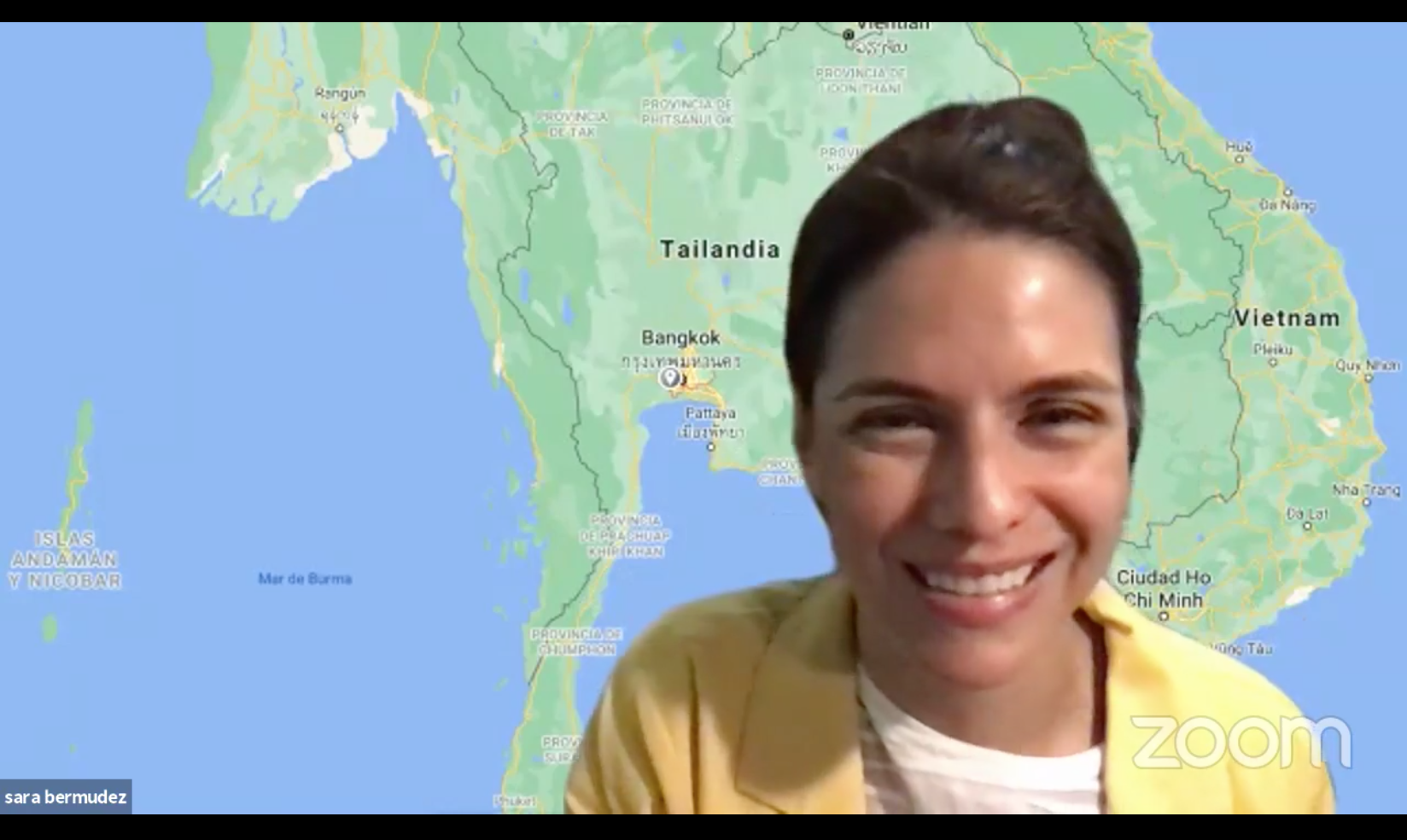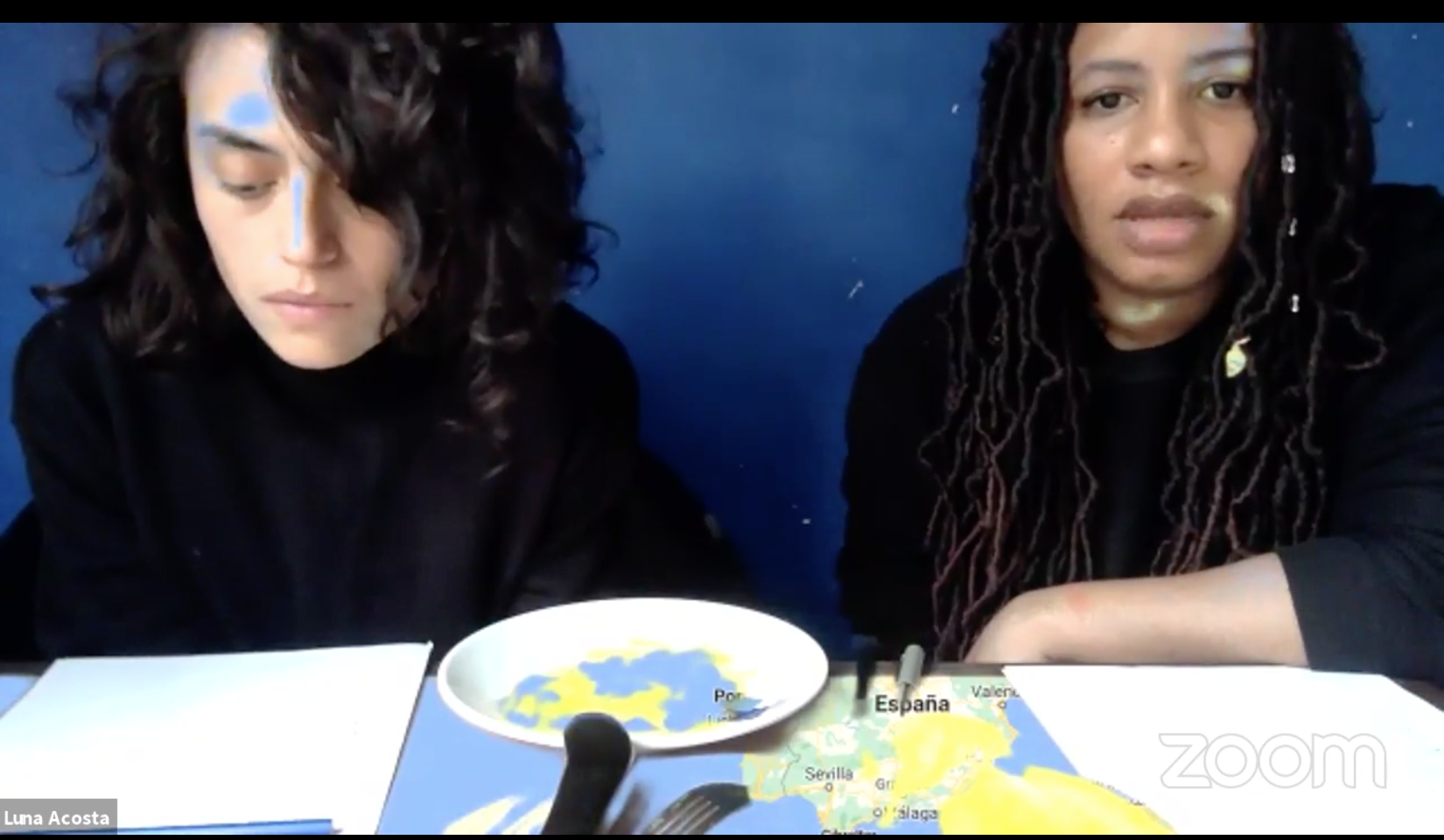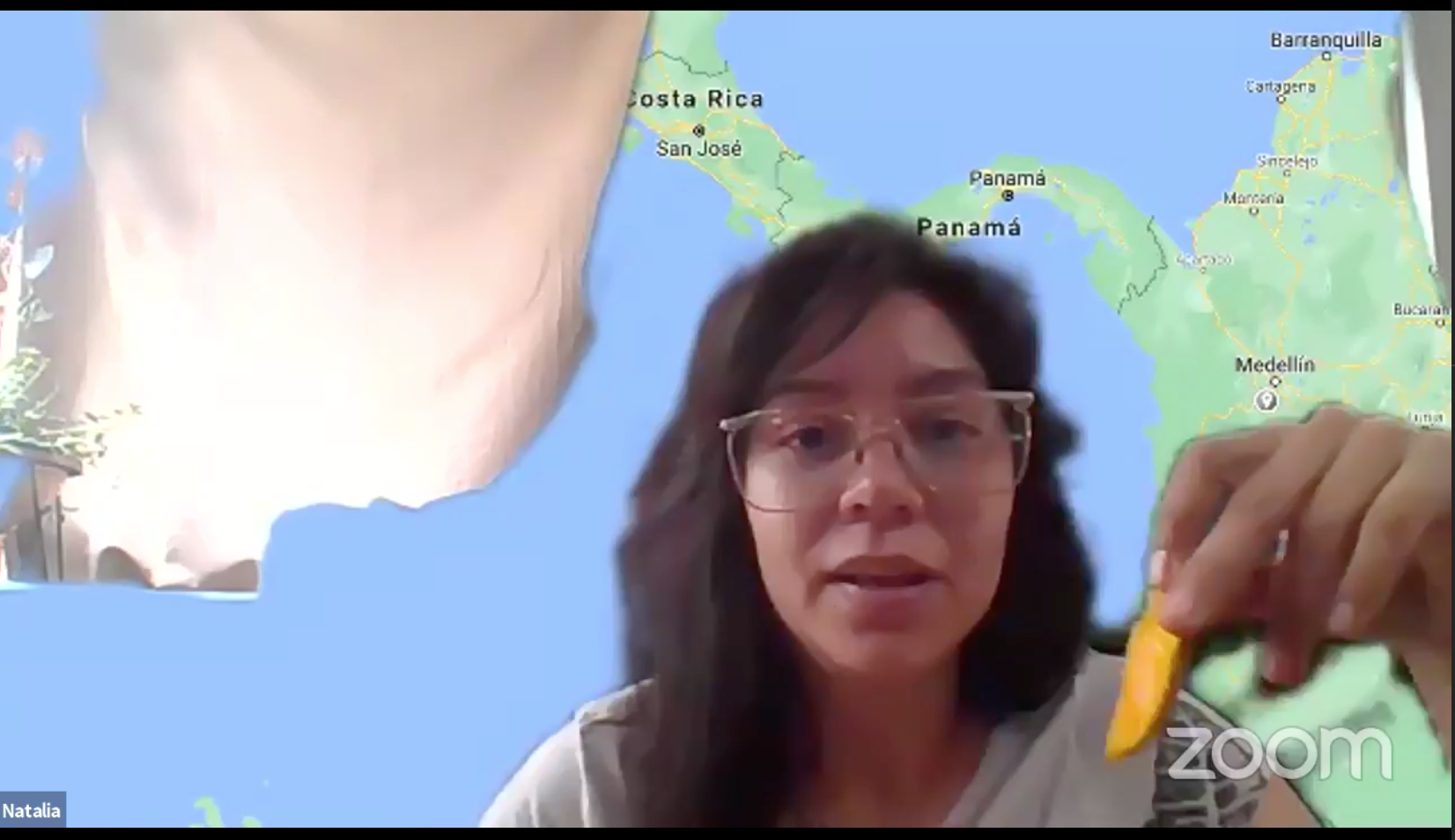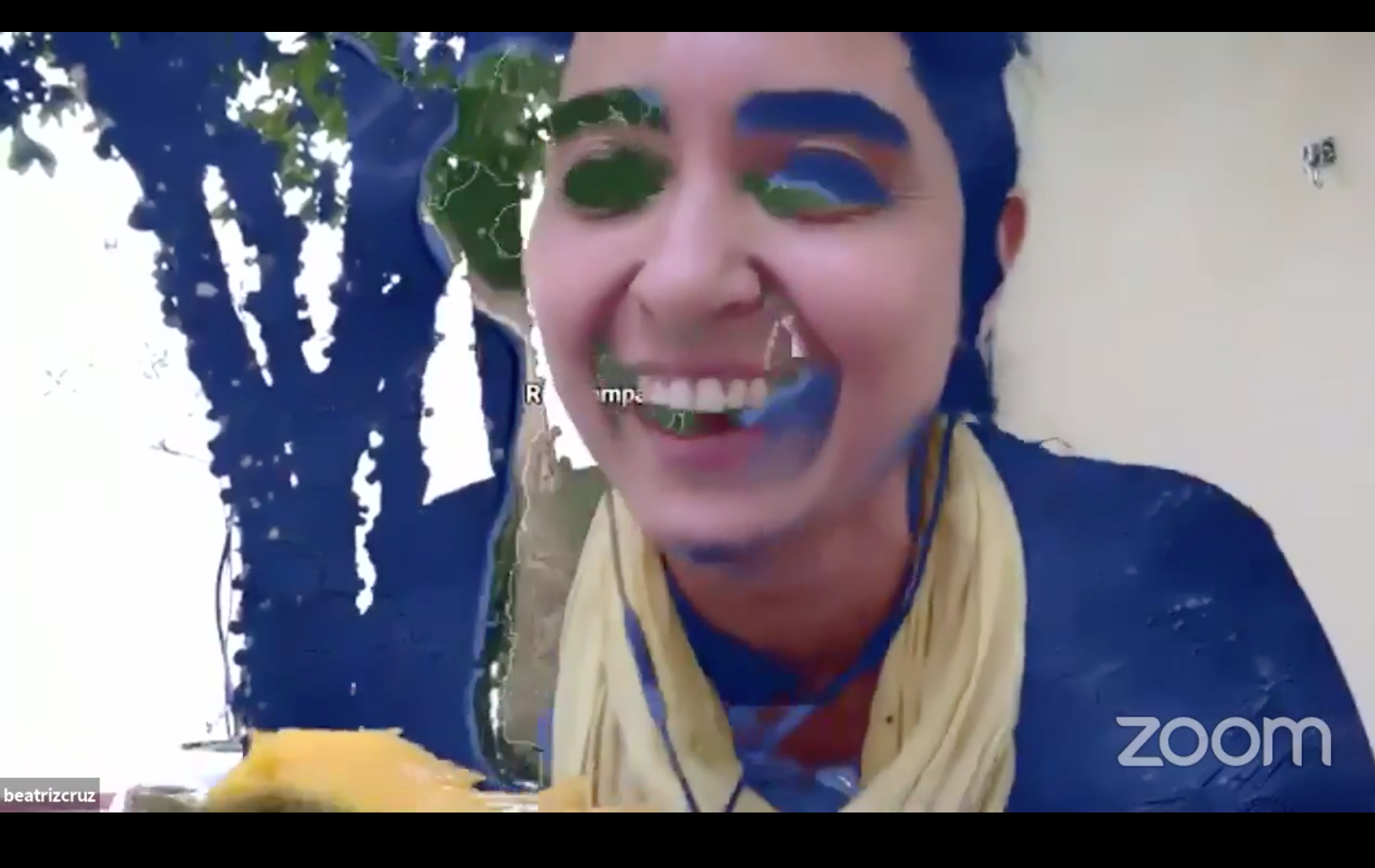Soft tech





Online Performance
Cyberbodies festival
Performance Kokkenet (Copenhagen)
October 2020
Cyberbodies festival
Performance Kokkenet (Copenhagen)
October 2020
Traducción simultánea: Lizette Nin
Invitadas: Marcela Acosta (India), Sara Bermudez (Tailandia), Natalia Garzón (Colombia), Beatriz Cruz (Brasil)
Invitadas: Marcela Acosta (India), Sara Bermudez (Tailandia), Natalia Garzón (Colombia), Beatriz Cruz (Brasil)
Simultaneous translation: Lizette Nin
Guests: Marcela Acosta (India), Sara Bermudez (Tailand), Natalia Garzón (Colombia), Beatriz Cruz (Brazil)
Guests: Marcela Acosta (India), Sara Bermudez (Tailand), Natalia Garzón (Colombia), Beatriz Cruz (Brazil)
Cuando pienso en mi territorio y en maneras de conectarme con él estando lejos, lo que me transporta más fácil son los olores y los sabores. Me gusta comer. Recuerdo con la barriga.
Pienso en el olor y en el sabor como tecnologías de la memoria y el conocimiento.Tecnologías como cajas de herramientas para relacionarnos con cuerpos, problemas, necesidades y medios específicos. Me pregunto sobre las tecnologías que podemos diseñar para estar juntas estando lejos y comprender el contexto específico de esas distancias.
Qué significa estar lejos y de qué manera se regulan esas distancias entre los cuerpos? Cuales son las posibilidades migratorias de cuerpos tropicales humanos y no humanos desde y hacia los mismos territorios?
Qué significa que una fruta tropical que activa en mi cuerpo relaciones somáticas llegue hasta esta lengua migrante que habita el territorio europeo?
Cuando llegué a España, en mi trabajo sinpapeles durante un año, le partí y le di de comer todos los días, un mango maduro al hombre que cuidaba. En España se consume per cápita 0,58 kilos de mango por año.
Existe un servicio directo a Europa en el que cuatro buques con capacidad de 1.800 TEU, traen frutas directamente desde Brasil entre diciembre y febrero. 1800 TEU son 21.600 kilogramos. ¿Cuántos árboles se necesitan para producir 21600 kilogramos de mangos?
Estar lejos de casa y comerme un mango del trópico es un poco, recordar mi infancia y su sabor a monte y a caribe y un poco recordar la devastación que esta memoria implica.
¿Cuántos mangos se necesitan para resolver los trámites burocráticos migratorios del humano del trópico en el norte global?
¿Cuántos mangos son un visado?
¿Cuánta muerte, cuánto destierro y cuánto fuego cabe en el sabor del recuerdo del trópico?
Descripción
Performance online realizada en el festival Cyberbodies de Performance Kokenet (Copenhague)
Invité a personas nacidas en Colombia y Brasil que son o han sido migrantes y que en el momento de la acción estaban ubicadas en Brasil, Colombia, Tailandia e India. Junto a mi, en Barcelona, había una persona que hacía una traducción simultánea al inglés de lo que yo hablaba en español.
A las asistentes se les invitó a llevar un mango a la acción.
Al igual que yo, cada una de las invitadas habló sobre los procesos de producción y distribución del mango en el territorio desde donde hablaban, mezclado con relatos afectivos y políticos en relación a la fruta, la memoria, la colonización, el género, el extractivismo.
Se abrió una charla alrededor de todo con todas las personas asistentes.
Dirigí una meditación sobre mango, migración, políticas extractivas del norte global, memoria y sanaciones somáticas.
Pienso en el olor y en el sabor como tecnologías de la memoria y el conocimiento.Tecnologías como cajas de herramientas para relacionarnos con cuerpos, problemas, necesidades y medios específicos. Me pregunto sobre las tecnologías que podemos diseñar para estar juntas estando lejos y comprender el contexto específico de esas distancias.
Qué significa estar lejos y de qué manera se regulan esas distancias entre los cuerpos? Cuales son las posibilidades migratorias de cuerpos tropicales humanos y no humanos desde y hacia los mismos territorios?
Qué significa que una fruta tropical que activa en mi cuerpo relaciones somáticas llegue hasta esta lengua migrante que habita el territorio europeo?
Cuando llegué a España, en mi trabajo sinpapeles durante un año, le partí y le di de comer todos los días, un mango maduro al hombre que cuidaba. En España se consume per cápita 0,58 kilos de mango por año.
Existe un servicio directo a Europa en el que cuatro buques con capacidad de 1.800 TEU, traen frutas directamente desde Brasil entre diciembre y febrero. 1800 TEU son 21.600 kilogramos. ¿Cuántos árboles se necesitan para producir 21600 kilogramos de mangos?
Estar lejos de casa y comerme un mango del trópico es un poco, recordar mi infancia y su sabor a monte y a caribe y un poco recordar la devastación que esta memoria implica.
¿Cuántos mangos se necesitan para resolver los trámites burocráticos migratorios del humano del trópico en el norte global?
¿Cuántos mangos son un visado?
¿Cuánta muerte, cuánto destierro y cuánto fuego cabe en el sabor del recuerdo del trópico?
Descripción
Performance online realizada en el festival Cyberbodies de Performance Kokenet (Copenhague)
Invité a personas nacidas en Colombia y Brasil que son o han sido migrantes y que en el momento de la acción estaban ubicadas en Brasil, Colombia, Tailandia e India. Junto a mi, en Barcelona, había una persona que hacía una traducción simultánea al inglés de lo que yo hablaba en español.
A las asistentes se les invitó a llevar un mango a la acción.
Al igual que yo, cada una de las invitadas habló sobre los procesos de producción y distribución del mango en el territorio desde donde hablaban, mezclado con relatos afectivos y políticos en relación a la fruta, la memoria, la colonización, el género, el extractivismo.
Se abrió una charla alrededor de todo con todas las personas asistentes.
Dirigí una meditación sobre mango, migración, políticas extractivas del norte global, memoria y sanaciones somáticas.
When I think about my territory and ways to connect with it from a distance, what transports me the easiest are the smells and tastes. I like to eat. I remember with the belly.
I think of smell and taste as technologies of memory and knowledge.Technologies such as toolboxes to relate to specific bodies, problems, needs and media. I wonder about the technologies that we can design to be together while being far away and understand the specific context of those distances.
What does it mean to be far away and in what way are these distances between bodies regulated? What are the migratory possibilities of human and non-human tropical bodies from and to the same territories?
What does it mean that a tropical fruit that activates somatic relationships in my body reaches this migrant language that inhabits the European territory?
When I arrived in Spain, I worked “without paper” for a year. Everyday in my job I had to split a ripe mango to feed the man I was caring for. In Spain, 0.58 kilos of mango are consumed per capita per year.
There is a direct service to Europe in which four vessels with a capacity of 1,800 TEU, extract fruits directly from Brazil between December and February. 1800 TEU is 21,600 kilograms.
How many trees does it take to grow 21,600 kilograms of mangoes?
Being far from home and eating a mango from the tropics is a bit of a thing, remembering my childhood and its taste of the mountains and the Caribbean and a little remembering the devastation that this memory implies.
How many mangoes are needed to solve the migration bureaucratic procedures of tropical humans in the global north?
How many mangoes are a visa?
How much death, how much exile and how much fire fits in the taste of the memory of the tropics?
Description
I invited 4 people born in Colombia and Brazil who are or have been migrants and who at the time of the action were located in Brazil, Colombia, Thailand and India. Next to me, in Barcelona, there was a person who did a simultaneous translation into English of what I spoke in Spanish.
Attendees were asked to bring a mango to the meeting by zoom
Like me, each of the 4 guests spoke about the mango production and distribution processes in the territory from which they spoke, mixed with affective and political stories in relation to the fruit, memory, colonization, sex, extractivism, etc.
The talk was opened to all the people in the room.
I led a meditation on mango, migration, extractive politics of the global north, memory and somatic healings.
I think of smell and taste as technologies of memory and knowledge.Technologies such as toolboxes to relate to specific bodies, problems, needs and media. I wonder about the technologies that we can design to be together while being far away and understand the specific context of those distances.
What does it mean to be far away and in what way are these distances between bodies regulated? What are the migratory possibilities of human and non-human tropical bodies from and to the same territories?
What does it mean that a tropical fruit that activates somatic relationships in my body reaches this migrant language that inhabits the European territory?
When I arrived in Spain, I worked “without paper” for a year. Everyday in my job I had to split a ripe mango to feed the man I was caring for. In Spain, 0.58 kilos of mango are consumed per capita per year.
There is a direct service to Europe in which four vessels with a capacity of 1,800 TEU, extract fruits directly from Brazil between December and February. 1800 TEU is 21,600 kilograms.
How many trees does it take to grow 21,600 kilograms of mangoes?
Being far from home and eating a mango from the tropics is a bit of a thing, remembering my childhood and its taste of the mountains and the Caribbean and a little remembering the devastation that this memory implies.
How many mangoes are needed to solve the migration bureaucratic procedures of tropical humans in the global north?
How many mangoes are a visa?
How much death, how much exile and how much fire fits in the taste of the memory of the tropics?
Description
I invited 4 people born in Colombia and Brazil who are or have been migrants and who at the time of the action were located in Brazil, Colombia, Thailand and India. Next to me, in Barcelona, there was a person who did a simultaneous translation into English of what I spoke in Spanish.
Attendees were asked to bring a mango to the meeting by zoom
Like me, each of the 4 guests spoke about the mango production and distribution processes in the territory from which they spoke, mixed with affective and political stories in relation to the fruit, memory, colonization, sex, extractivism, etc.
The talk was opened to all the people in the room.
I led a meditation on mango, migration, extractive politics of the global north, memory and somatic healings.
